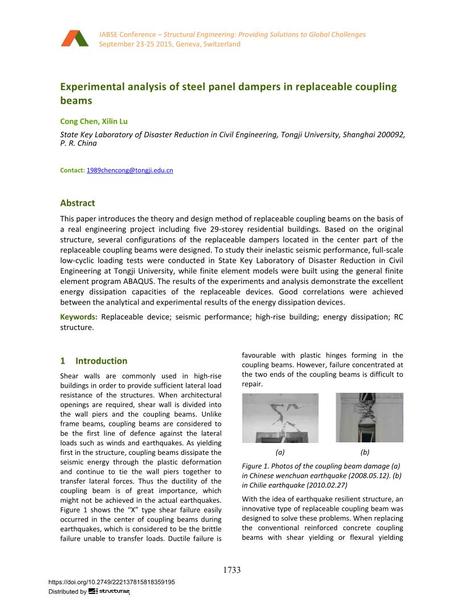Experimental analysis of steel panel dampers in replaceable coupling beams

|
|
|||||||||||
Détails bibliographiques
| Auteur(s): |
Cong Chen
(State Key Laboratory of Disaster Reduction in Civil Engineering, Tongji University, Shanghai 200092, P. R. China)
Xilin Lu (State Key Laboratory of Disaster Reduction in Civil Engineering, Tongji University, Shanghai 200092, P. R. China) |
||||
|---|---|---|---|---|---|
| Médium: | papier de conférence | ||||
| Langue(s): | anglais | ||||
| Conférence: | IABSE Conference: Structural Engineering: Providing Solutions to Global Challenges, Geneva, Switzerland, September 2015 | ||||
| Publié dans: | IABSE Conference Geneva 2015 | ||||
|
|||||
| Page(s): | 1733-1739 | ||||
| Nombre total de pages (du PDF): | 7 | ||||
| Année: | 2015 | ||||
| DOI: | 10.2749/222137815818359195 | ||||
| Abstrait: |
This paper introduces the theory and design method of replaceable coupling beams on the basis of a real engineering project including five 29-storey residential buildings. Based on the original structure, several configurations of the replaceable dampers located in the center part of the replaceable coupling beams were designed. To study their inelastic seismic performance, full-scale low-cyclic loading tests were conducted in State Key Laboratory of Disaster Reduction in Civil Engineering at Tongji University, while finite element models were built using the general finite element program ABAQUS. The results of the experiments and analysis demonstrate the excellent energy dissipation capacities of the replaceable devices. Good correlations were achieved between the analytical and experimental results of the energy dissipation devices. |
||||
| Mots-clé: |
bâtiment haut
|
||||
